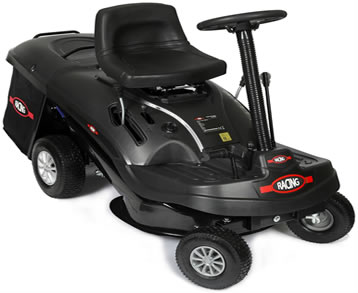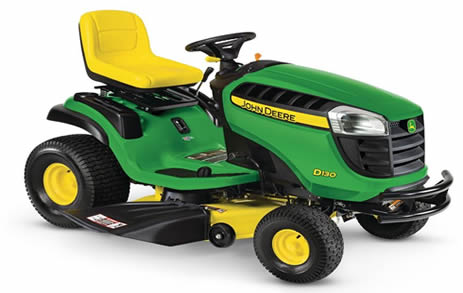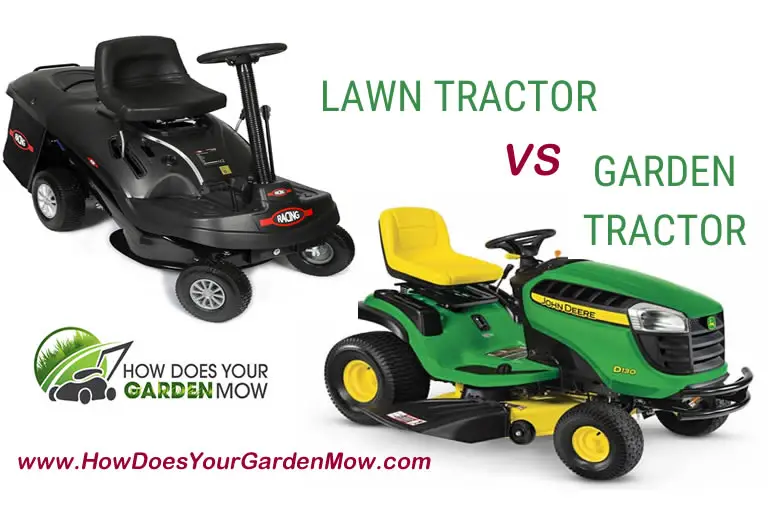If you’re fed up with pushing a lawn mower under the scorching heat then a riding mower, in the form of a lawn tractor or garden tractor, might be your one-way ticket to greater convenience when it comes to trimming your lawn. However, buying one can be a little tricky, especially if you do not know the difference between a lawn tractor and a garden tractor.
In this article I will highlight the key differences between the two machines so you can make a more informed choice about which type is a better fit for your needs.
Table of Contents
- The Difference Between Lawn Tractor And Garden Tractor
- Garden tractor vs lawn tractor: the 5 main differences
- Lawn vs garden tractor: How to decide which machine is a better fit for your needs
- Frequently asked questions about lawn tractors vs garden tractors
- Our choice of best lawn tractor
- Our choice of the 2 best garden tractors
- Conclusion: The difference between a lawn tractor and a garden tractor
The Difference Between Lawn Tractor And Garden Tractor
Before we begin you should be aware that there is a popular trend to use the terms lawn tractor and garden tractor interchangeably. Although this is becoming more common place there are actually some distinct differences between these two type of machines. So, do not be too hard on yourself if you have had difficultly understanding the difference between the two!
In this article, we will not only tell you the difference between a lawn tractor and a garden tractor but we will also help you decide which one will suit your needs and requirements best.
At a glance, both tractors look the same and perform similar functions at their base level. They’re both riding lawn mowers which means both of them allow you to sit on the machine and operate it like an automatic road vehicle while also giving you full control over the cutting blades and deck that are used to cut the grass, but they’re not identical.
Let us define each now.
The definition of a lawn tractor
A lawn tractor is probably closest of the two machines to the traditional ‘riding lawn mower’ that most people imagine.
An engine located at the back with the mowing deck placed under the front seated area for convenient grass-trimming is typical of a lawn tractor.
These mowers are small and don’t offer much more cutting power than a self-propelled walk behind mower. But they do have the convivence of a seat and steering wheel.

However, it is necessary to keep in mind that they are much less powerful than garden tractors. This also come much fewer features.
However, a lawn tractor doesn’t only cut the grass but can also perform other tasks, such as pulling a cart, all with adding a few attachments and accessories that are usually provided by the manufacturer.
They are generally comfortable thanks to better seats and other such features.
In terms of size, lawn tractors are built heavier and arguably larger in size than traditional lawn mowers with a wider cutting deck, with the exception of wide area self-propelled walk-behind mowers and wide area push mowers.
A typical example of a lawn tractor is the Troy Bilt TB30R.
How a garden tractor differs from a lawn tractor
Garden tractors are considered an upgrade from lawn tractors.
These versatile machines do much more than just cut grass and haul carts.
They can even work as snow throwers, seeders, and even backhoes – all by adding a few accessories.

While they work well, they can be a little harder to maneuver than lawn tractors.
However, they make up for this shortcoming with features such as a more powerful engine. This is also why garden tractors are bigger. This is why they also cost more.
Typical garden tractors are the X330 and S240 John Deere riding mowers.
You can see a wide range of riding mowers in our review of the top models here.
Garden tractor vs lawn tractor: the 5 main differences
Now that we have established what each tractor has to offer, let’s jump right into the main differences between the two.
1. Engine power
As mentioned before, garden tractors have bigger and more powerful engines – 29 HP versus 15 HP on average.
This is of huge importance because engine power decides how reliable and quick a machine is. Plus, we must also mention that bigger engines consume more power.
2. Cutting width
Lawn tractors tend to have a much smaller cutting width, offer a cutting width of around the 30 inches mark. This is not that bad, but garden tractors hit the ball out of the park with much larger cutting decks and cutting widths up to 54 inches.
It is vital to pay attention to this factor because more width means you will have to spend less time on your garden as you will be able to cover more space in one go.
Most larger machines also have a tighter turning radius and of course zero turn riding mowers can literally turn on a dime.
3. Attachments and additional accessories
Versatility is the mark of the difference between a lawn tractor and a garden tractor.
While both tractors allow you to pull a cart as an added attachment that’s the only thing you can use on a small lawn tractor.
The larger garden tractors have much more attachments available fro a wide range of different activities from soil tilling to snow plowing.
Additionally any accessories and attachments lawn tractors come with are typically not very powerful as these machines are not built for heavy work. Only small carts can be attached to these machines for hauling fairly light lawn supplies. Garden tractors can haul even the type of heavy-duty pull behind carts that used for commercial landscaping.
Garden tractors, however, come with heavy-duty accessories and attachments that work well in a myriad of situations from seeding and salting to spraying and everything in-between.
4. Fuel tank capacity
Another difference that is worth mentioning, and that also plays a role in the functionality of any lawn or garden tractor, is the fuel tank capacity.
It can be hard to tell exactly how much capacity a machine offers as it depends on several factors beyond just the specific model, this includes the manufacturer. Nonetheless, lawn tractors usually have a maximum capacity of 11.5 liters but some of the smaller riding mowers go as low as 3 liters.
On the other hand, the larger garden tractors have a maximum capacity of up to 19 liters. More capacity of course means fewer refills and larger areas cut (when mowing).
You will be able to go on longer without needing fuel. This is one reason (along with the attachment versatility) that commercial landscapers will more often than not use larger garden tractors in preference over smaller lawn tractors.
Don’t be surprised if they use the term interchangeably though as even professionals are being to adopt this terminology.
Look at the size of your lawn and how often you need to use a lawnmower to decide how big of a tank you require.
5. Power take-off type
In tractor language, power take-off or PTO refers to the use of energy transmitted by the engine of a tractor.
This PTO is used not only to power the machine itself and its cutting deck but is also used to power another additional attachments.
Lawn tractors make use of an electric PTO. This is the traditional PTO. It uses energy from the engine to power the mowing blades. It also helps to keep the tractor in place.
In contrast to this, larger garden tractors will consist of a PTO that comes with a hydraulic clutch. This clutch is said to be more reliable and faster.
This is also why some people think that certain garden tractors can be a little difficult to use as some machines have a clutch system that comes with a learning curve.
Lawn vs garden tractor: How to decide which machine is a better fit for your needs
Now that we have established the differences between a lawn tractor and a garden tractor, let’s move on to the next important questions, which one should you choose and which one will fit your gardening needs best?
The following factors will help you make the right call.
a) Consider your yard size
Perhaps the most important factor to keep in mind when choosing between a smaller lawn tractor and a larger garden tractor is the size of your yard.
Although a small lawn tractor can be used in any sized lawn, even very large ones (albeit with constant refueling and longer cut times, the larger garden tractors may be too big and have to large a turning radius for some smaller, or awkwardly designed, lawns.
Although a garden tractor is superior in just about every way to a smaller lawn tractor, these differences are of no positive use if the size of your yard can only support a small mower.
An easy way to determine which type of machine is better for your particular yard is by comparing the average horsepower that a tractor has to offer against the acreage of your yard.
Here is a simple table to help you determine that.
| Acre Measurement | Recommended Tractor | Recommended hp and cutting deck measurement |
| ½ acre – 1 acre | lawn tractor | 14 horsepower/36″ – 40″ cutting deck |
| 1 acre – 2 acre | lawn tractor or garden tractor | 16 hp/42″ – 46″cutting deck |
| 3+ acre and above | garden tractor or zero turn mower | 24 hp/46″ – 54″ cutting deck |
Other than these measurements, another thing to consider the type of greenery your lawn contains. If all you have is grass and a wide mowing area, then a garden tractor with a wide cutting deck of 46″+ will work best.
However, if you have flowerbeds and other forms of trees and bushes placed at awkward angles then a large mowing deck might not be the best. In fact, it might hinder the cutting process. You may also need the superior maneuverability of a top-of-the-range zero turn mower.
b) The type of yard activities you need the machine for should also influence your choice
As mentioned earlier, lawn and garden tractors aren’t only used to trim grass. The most common jobs they are used for include:
- Towing a small spreader.
- Towing a sprayer.
- Pulling a wagon.
If this is all you’re interested in then opt for a lawn tractor.
But, if you want to do more then it might be a good idea to choose a garden tractor as it can do the following:
- Moving and towing heavy loads.
- Aerating your yard.
- Clearing snow during winter.
- Plowing large amounts of dirt and even heavy wet snow.
- Furrowing.
At the end of the day, it depends on what you need to use the machine for.
c) The surface of the area where you will use the machine can directly affect your choices
If the surface of your yard is flat with no huge bumps or hills then you’ll be good with a small lawn tractor. However, if it’s bumpy then it is best that you opt for a garden tractor with better traction.
Garden tractors come with a special feature called the locking differential that ensures the machine remains still even if it’s on an inclined surface.
In our opinion, these are the top three factors that you should consider before deciding on the type of lawn or garden tractor you want to purchase.
Frequently asked questions about lawn tractors vs garden tractors
What if I want to purchase a lawn tractor even though my yard is very large?
If you still prefer going for a smaller, and cheaper, lawn tractor rather than the bigger garden tractor, then you will have to ensure that it is one that comes with a powerful engine – at least around 15 HP – and a large enough fuel tank.
Another factor that comes into play is the size of the mowing deck. With a larger mowing deck, you will be able to cover a larger area. You will want to aim for a lawn tractor with the largest cutting deck available – preferably 40″.
A lawn tractor is more than capable of mowing any size lawn – as long as you have the patience to stick with the task.
All in all, if you want to go for a lawn tractor, then waste no time and go for it. It might result in longer time time mowing the lawn but it will get the job done as long as you keep refueling it.
Is there any difference between a riding mower and a lawn or garden tractor?
Lawn tractors and a garden tractors are both riding mowers.
Along with the key differences of engine size, deck size and ability to perform other tasks (with attachments) another minor difference between the two machines lies in the location of the engine.
In the case of most lawn tractors, the engine is located at the rear of the rear of the vehicle. On the other hand, larger garden tractors have a front-mounted engine. Garden tractors are also much larger than lawn tractors, which are entry-level riding mowers.
Other than this, there is not a major difference between the designs.
Our choice of best lawn tractor
Decided to go for a lawn tractor?
We have picked the best one on the market to help you make the right call.
Troy-Bilt TB30R
This is a great entry-level riding mower perfect for residential lawns and small and medium sized yards.
Pros:
- Lightweight.
- Easy-to-use.
- 30″ cutting deck.
- 18″ cutting radius.
- 2-year warranty.
Cons:
- No gas gauge to display fuel levels.
- Limited accessories and attachments.
- Only powerful enough to pull small cart.
For more in-depth specs and a full review go here.
Our choice of the 2 best garden tractors
If you have decided to go for a garden tractor then check this review of one of the best options on the market.
1. Husqvarna YTH18542 Hydrostatic garden tractor
This Husqvarna machine is easy to use and works like a charm. It would not be incorrect to call this a professional grade garden tractor even though it is not marketed as a commercial machine.
It has an 18.5 HP Briggs & Stratton (USA made) engine, along with a mowing deck that measures 42 inches.
Additionally, its 2.5 gallon fuel tank is enough for a medium-sized lawn. Moreover, you don’t need to worry about wear and tear with this garden tractor as it is made of a heavy duty steel frame.
Another great feature of the garden tractor is its compact size. Storing it is easy and you will not have to worry about space.
And to hit the ball out of the park, the tractor comes with special anti-scalping wheels that prevent any scalping of your lawn that may occur on uneven grounds (previously a serious problem with all types of riding mowers). Hence, you will get a nice clean and even cut with this beauty.
Pros:
- Comes with a 2-year warranty.
- Powerful engine for professional use.
- Solid built and easy to use.
- Can handle a wide range of accessories and attachments for all gardening and snow-clearing needs.
- Anti-scalping technology.
Cons:
- No gas gauge to display fuel levels.
Get your hands on this gas powered, manual machine if you are looking for a tractor that is compact and easy to use.
2. Troy-Bilt 46-inch garden tractor
With a 19.5 HP Briggs & Stratton (USA made) engine, this machine is powerful and reliable.
The tractor has a mowing deck that measures 46-inches and offers a variety of cutting heights: five to be exact. You can even add multiple accessories to get more out of this beauty.
The best thing about this tractor is its ability to allow users to cut in reverse, which is a feature not available on all machines.
With a special seat design that offers excellent back support, it is one of the most comfortable mid-range garden tractors out there. We also love its soft and patented steering wheel that offers a soft grip without compromising on control.
Pros:
- Powerful engine.
- Wide 46″ cutting width.
- Perfect for larger mid-sized lawns or commercial use.
- Soft seat for mid-back support.
- Comes with a 2-year warranty.
- Reverse cut.
- Supports a range of accessories and attachments.
Cons:
- A little on the expensive side.
Although expensive, this Troy-Bilt garden tractor offers you exactly what you pay for, from user comfort to superior build quality. Get your hands on this one if you want a durable machine that offers more than just basic features.
Conclusion: The difference between a lawn tractor and a garden tractor
We hope this article helped you understand the difference between the two different type of small personal-use tractors while also allowing you to come to a final decision about which type is the best for for your specific needs.
Whether you purchase a lawn tractor or a garden tractor, both options will undoubtedly add comfort to your garden maintaining duties as they offer a lot more convenience and versatility than a push mower. Just be aware that as you read reviews online, and look at different machines, the terms lawn tractor and garden tractor are now being commonly used interchangeably between the two different types of riding mower even by manufacturers and retailers.

